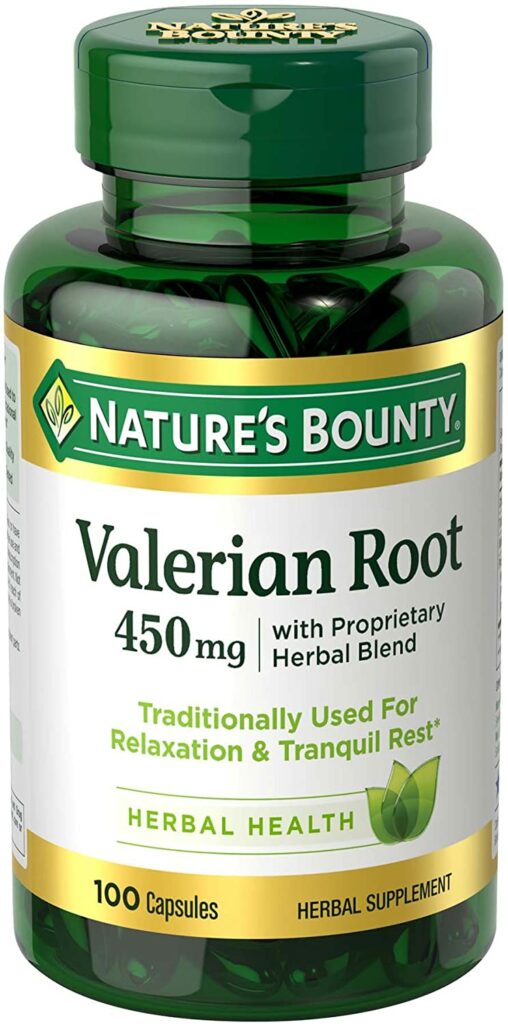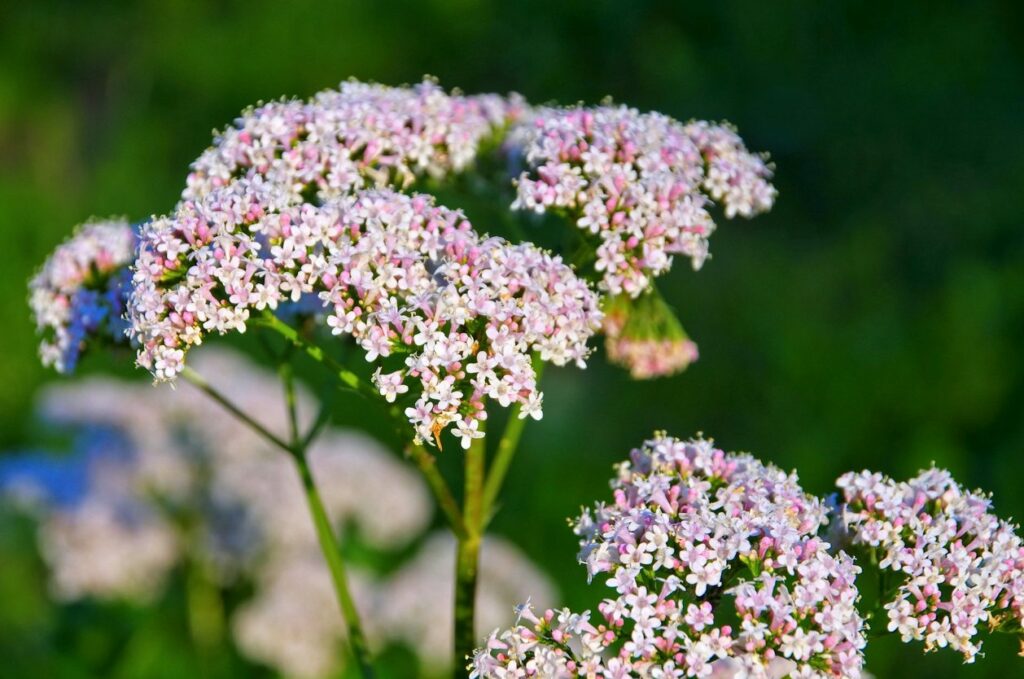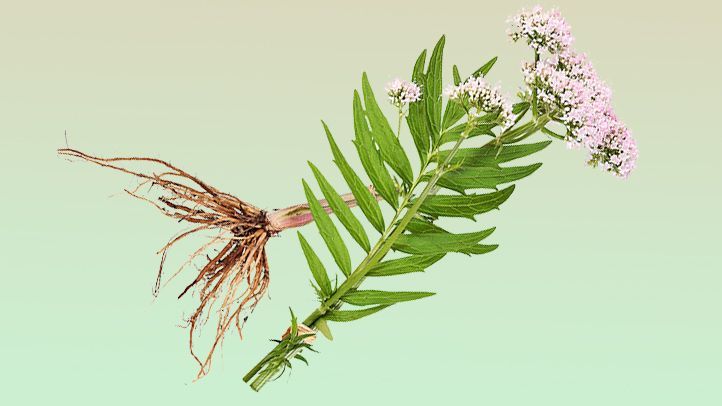Table of Contents
Museum members support scholarship like this.
Valerian has been used as a medicinal plant at least since the time of ancient Greece and Rome. Its beneficial uses were described by Hippocrates, and in the 2nd century when Galen prescribed it for insomnia. In the 16th century, it was used to treat nervousness, trembling, headaches, and heart palpitations. In the mid-19th century, Valerian was considered a stimulant that caused some of the same complaints it was thought to treat and was generally held in low esteem as a medicinal agent. During World War I, Valerian was used to treat shellshocked solders, and during World War II it was used in England to relieve the stress of air raids.1,2
Valerian is derived from the root of the Valerian plant and its various formulations were listed as official preparations in the Civil War period medical and pharmaceutical compendia. It was primarily used as a sedative to quiet nervous excitement in conditions such as hysteria, nervous headaches, hypochondriasis, nervous restlessness, epilepsy and other nervous disorders. In small doses, Valerian was considered a gentle stimulant without a narcotic effect and having a direct action on the central nervous system producing a stimulant or antispasmodic effect. Large doses resulted in mental excitement, visual disturbances such as scintillation and flashes of light, giddiness, restlessness, agitation and even spasmodic movements. However, large doses could also produce a slight narcotic effect causing heaviness, drowsiness, headaches and a reduced heart rate. When combined with Peruvian Bark it was used in the treatment of intermittent fevers.3-8

Formulations
The majority of the effects of Valerian were due to its volatile oil which contains Valerianic acid. The most commonly used preparations were the fluid and alcoholic extracts, infusion, oil and tinctures. Valerian powder was rarely used because some objected to the quantity of inert woody fibers it contained. However, when well-made and freshly prepared, it was an effective formulation for administration in a dose of 30 to 90 grains or 2 to 6 grams taken 3 to 4 times a day. Valerian was not typically administered as decoction.5,8
Fluid Extract of Valerian (Extractum Valerianae Fluidum)
The fluid extract of Valerian represented a concentrated preparation of Valerian. Six ounces of fine Valerian powder were moistened with 6 ounces of alcohol and pressed firmly into a conical percolator. Additional alcohol was gradually added until 12 ounces of the tincture was collected. This was set aside, and the percolation was continued until 2 more pints were collected. The tincture was then evaporated at a temperature not exceeding 120o F to a final volume of 4 ounces. This mixture was then added to the initially collected tincture and then filtered through filter paper. The dose of the fluid extract was 1 to 2 fluidrachms.3-5,8

Alcoholic Extract of Valerian (Extractum Valerianae Alcoholicum)
Twelve ounces of fine Valerian powder was moistened with 4 ounces of alcohol and packed into a percolator and then an additional 12 ounces of alcohol was gradually added. After the alcohol was completely absorbed by the powder, dilutedalcohol (full strength alcohol diluted with an equal volume of distilled water) was added until a pint of tincture was collected.The liquid was set aside in a warm place and allowed to evaporate spontaneously until reduced to 3 ounces. The percolation was continued with diluted alcohol until 2 more pints of the tincture were collected and then evaporated by means of a water-bath to the consistency of a syrup. Lastly, the two liquids were mixed, and the evaporation continued at a temperature not exceeding 120o F, until the mixture was reduced to the proper consistency. The recommended dose was 1 to 2 fluidrachms.3,5
Infusion of Valerian (Infusum Valerianae)
Half an ounce of moderately course Valerian powder was mixed with 2 fluidrachms of water and packed firmly into a conical percolator. Water was gradually added until a pint of filtered liquid was collected. The infusion may also have been made by steeping the Valerian with a pint of boiling water for 2 hours in a covered vessel and strained. The infusion was used as a tonic or antispasmodic for the treatment of hysteria in a dose of 1 ½ to 2 ounces 2 to 4 times a day, or more frequently when the powder could not be tolerated.3,5,7,8
Oil of Valerian (Oleum Valerianae)
Valerian powder was added to a vessel suitable for distillation and enough water was added to cover the powder. The mixture was distilled by regulated heat into a large cool vessel where the Valerian oil was separated from the water. The oil of Valerian produced the same effect on the central nervous system as the root and was frequently administered as a substitute for it in a dose of 1 to 5 drops which could be added to a pill or emulsion.3-5,7
Tincture of Valerian (Tinctura Valerianae)
Four ounces of moderately fine Valerian powder was moistened with 1 ounce of diluted alcohol and packed into a conical percolator and then additional diluted alcohol was gradually added until 2 pints of the tincture were obtained. In the typical dose of ½ to 4 fluidrachms, the tincture was used as a stimulant or antispasmodic for the treatment of nervousness and spasmodic affections but was considered less effective than the powder. The large dose of the tincture required was considered objectionable because of the proportion of alcohol contained in the dose was too great to warrant its repeated administration.3-8

Ammoniated Tincture of Valerian (Tinctura Valerianae Ammoniata)
Four ounces of moderately fine Valerian powder was mixed with 2 pints of aromatic spirit of ammonia, steeped for 7 days and then expressed and filtered through paper. The ammonia in this preparation was thought to assist the dissolving properties of the alcohol. The ammoniated tincture of Valerian was used the same way as tincture of Valerian. The ammonia was thought to augment its stimulant effects and make it more effective in the treatment of hysteria and other nervous affections. The dose was ½ to 2 fluidrachms in sweetened water, milk or some mucilaginous fluid.3-5,7,8
Valerian was the benzodiazepine (i.e., Ativan®, Librium®, Valium®, Xanax®) of the ages and was used in people prone to anxiety, overthinking and worrying. It worked by slowing down the nervous system producing a calming rather than a sedating effect, reducing stress levels and neck and shoulder muscle tension. It had the additional benefits of being relative side effect free and not being addictive. It’s interesting that Valerian was used for all of the same indications as modern-day benzodiazepines such as anxiety, nervousness, epilepsy and muscle tension. This makes sense as benzodiazepines and Valerian both increase gamma amino butyric acid (GABA) levels in the brain producing a calming and relaxing effect.2,9 I wonder what the marketing people were thinking when the selected VALium as the brand name for diazepam. I wonder if they had VALerian on their minds.
This is the eighth in a series of posts about the Pry House Medicinal Garden. Click below to be directed to the others.
PART ONE PART TWO PART THREE PART FOUR PART FIVE Part Six part seven
Want to learn more? Follow us on Facebook and Twitter to discover more stories from Civil War medicine!
Become a museum member and support our educational programs and research like this.
Endnotes
1. Valerian. Fact Sheet for Health Professionals. Available at: https://ods.od.nih.gov/factsheets/Valerian-HealthProfessional/ Accessed April 1, 2021
2. Farrell H. Healing with Plants. The Chelsea Physic Garden Herbal. London: Aster, 2021
3. National Medical Convention. The Pharmacopea of the United States of America. 4th ed. Philadelphia: Lippincott, Grambo and Co., 1864.
4. Edes RT. Therapeutic Handbook of the United States Pharmacopeia. New York: William Wood & Company, 1883.
5. Wood GB and Bache F. The Dispensatory of the United States of America. 11th ed. Philadelphia: J. B. Lippincott and Co., 1858.
6. Stille A. Therapeutics and Materia Medica: A Systematic Treatise of the Action and Uses of Medicinal Agents, Including Their Description and History. 4th ed. Philadelphia: Henry C. Lea, 1874.
7. Wythes JH. The Physician’s Pocket Dose and Symptom Book. Philadelphia: Lindsay and Blankston, 1861.
8. Pereira J. The Elements of Materia Medica and Therapeutics. Philadelphia: Lea and Blanchard, 1846.
9. Badal S and Delgoda (eds). Pharmacognosy Fundamentals, Applications and Strategy. London: Academic Press, 2017.
About the Author
Greg Susla has been a volunteer at the National Museum of Civil War Medicine since January 2011. Greg’s interest in the Civil War stems from his hometown, Torrington, CT, the birthplace of the abolitionist John Brown. Greg received his pharmacy degrees from the Universities of Connecticut and Florida and completed a critical care pharmacy residency at the Ohio State University Hospitals. Greg spent the majority of his career as the ICU pharmacist at National Institutes of Health in Bethesda, MD and is a Fellow in the American College of Critical Care Medicine. Greg retired as the Associate Director of Medical Information at MedImmune in Gaithersburg, MD. Greg is a University of Maryland Extension – Frederick County Master Gardener Intern. Greg and his wife Lisa live in Frederick, MD.
Further Reading List
- Stille A. Therapeutics and Materia Medica: A Systematic Treatise of the Action and Uses of Medicinal Agents, Including Their Description and History. 4th ed. Philadelphia: Henry C. Lea, 1874.
- Edes RT. Therapeutic Handbook of the United States Pharmacopeia. New York: William Wood & Company, 1883.
- Pereira J. The Elements of Materia Medica and Therapeutics. Philadelphia: Lea and Blanchard, 1846.
- Wood GB and Bache F. The Dispensatory of the United States of America. 11th ed. Philadelphia: J. B. Lippincott and Co., 1858.
- Standard Supply Table. In William Grace. The Army Surgeon’s Manual. New York: Baillier Brothers, 1864
- Surgeon General’s Office. C. S. A. Standard Supply Table of the Indigenous Remedies for Field Service and the Sick in Hospitals. Richmond, VA March 1, 1863.
- Duncan A. The Edinburgh Dispensatory. 8th ed. New York: James Eastburn and Co., 1818
- National Medical Convention. The Pharmacopea of the United States of America. 3rd ed. Philadelphia: Lippincott, Grambo and Co., 1851.
- Wythes JH. The Physician’s Pocket Dose and Symptom Book. Philadelphia: Lindsay and Blankston, 1853.
- National Medical Convention. The Pharmacopea of the United States of America. 3rd ed. Philadelphia: Lippincott, Grambo and Co., 1851.


